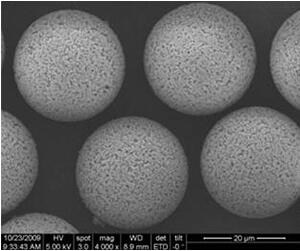Suzhou Nanomicro Technology Company, Ltd. (Nano-Micro) offers a new generation of monodisperse spherical polymeric chromatography media, produced using a patented technology that is developed in-house. These chromatography media are made from polystyrene (UniPS®), polymethyl methacrylate (UniPMM), copolymers of polystyrene and polymethyl methacrylate (UniPSN). The polymeric matrix, monodispersion and optimal porosity give rise to beneficial features of high resolution and loading capacity, strong rigidity, resistance against acid and base, low back pressure, long lifetime and low non-specific adsorption. Nano-Micro is proud to be a world-leading supplier of monodisperse polymeric chromatography media, with its unique technology of controlling particle size, size distribution, specific surface area, pore structure and functional groups.
Nano-Micro’s monodisperse polymeric chromatography media have been widely used in high performance liquid chromatography (HPLC) analysis, isolation and purification of organic compounds, proteins, polypeptides, nucleic acids, natural products and synthetic pharmaceuticals.

High uniformity of particle size
Our monodisperse polymeric media have perfect spherical shape, highly uniform particle size distribution, and precise particle size (Figures 1 and 2). Compared to other commercial chromatography media (with a broad particle size distribution in Figure 2), our media have demonstrated great advantages of strong rigidity, easy column packing, low back pressure, high column efficiency, good resolution, stable column bed and lower risk of frit-plugging.

Figure 1. SEM micrographs of UniPS® monodisperse spherical chromatography media

Figure 2. Particle size distribution of UniPS® (red) compared with well-known international brands (green)
Optimized pore structure
Pore size and specific surface area have a strong influence on the separation performance of chromatography media. The choice of a chromatography media with correct pore structure would improve the loading capacity, the column efficiency and the final purity of target molecule. We offer media with pore sizes typically from 50Å up to 1000Å.

Figure 3. SEM micrographs of UniPS® with different pore sizes
Superior chemical and pH stability
UniPS® chromatography media, made from highly cross-linked polymers of styrene and divinylbenzen, have excellent pH stability over a wide range of pH 1-14. Thesechromatography media maintain their outstanding physical and chemical stability even in extremely acidic or alkaline solutions (for e.g. 1 M NaOH/HCL) and organic solvents (such as methanol, ethanol, acetone, n-propanol, isopropanol, DMSO, THF, acetonitrile, 6 M guanidine hydrochloride, etc.). UniPS® provides the customers a wider choice of conditions for process development and optimization. The outstanding chemical stability, have been proven to meet the requirements of Cleaning-in-Place (CIP) in cGMP operations. For example, the loading capacity and separation efficiency remain unchanged, after a UniPS® 10-300 column was soaked in 1 M NaOH at 60°C for 40 days (Figure 4, used for Insulin purification).

Figure 4. Insulin loading capacity (breakthrough curve), when a UniPS® 10-300 column was soaked in 1 M NaOH (at 60°C) for up to 40 days
Large-scale Manufacturing Capability and Product Performance Consistency
Our state-of-the-art manufacturing facilities enable the bulk production of media, and a good quality control system assures the highest quality and batch-to-batch reproducibility. Figures 6, 7 and 8 showed the results of the performance test of more than twenty different lots of the chromatography media, indicating the good batch-to-batch reproducibility in our production.

Figure 5. Nano-Micro polymeric chromatography media in bulk packings

Figure 6. Consistent particle size and distribution in different lots of UniPS®

Figure 7. Stable pore volume and specific surface area in different lots of UniPS®

Figure 8. Reproducible isolation of four proteins by different lots of UniPS®
Different Polarity in Monodisperse Polymeric Chromatography Media
Nano-Micro provides customers more choices of different materials and surface polarity, for process optimization, for example UniPS®, UniPSN and UniPMM, with increasing surface polarity in that order.
Applications
Nano-Micro has an in-house application development group with vast experiences. This group support customers with a lot of technical services, from process development to technical transfer for production at industrial scale. Nano-Micro’s monodisperse polymeric chromatography media have been successfully applied to the isolation andpurification of plant extracts (taxol, docetaxel, huperzine, ascutellarin, stevioside, neomangiferin, myricetin, diosgenin, vinorelbine, ecdyson arbutin), antibiotics(vancomycin, derivatives of vancomycin, daptomycin, telavancin, caspofungin, Pneumocandin B0,teicoplanin, dalbavancin), polypeptides(thymalfasin, octreotide, oxytocin) and others(iohexol , iopamidol , acarbose).
List of Products
List of typical particle and pore sizes of Nano-Micro monodisperse spherical polymeric chromatography media*:

* Custom-made particle and pore sizes are available upon request.
bio-equip.cn














